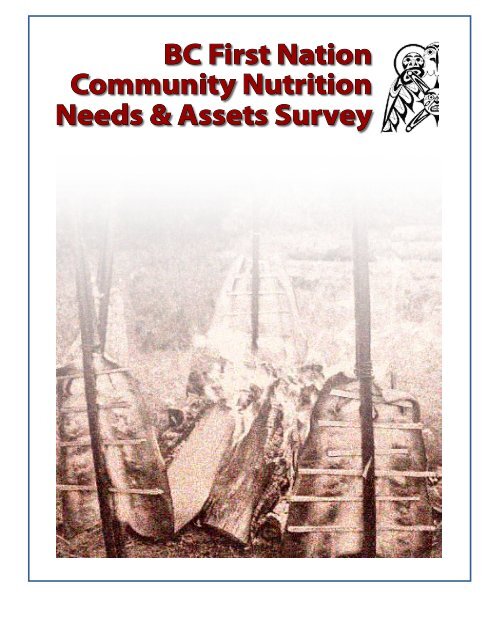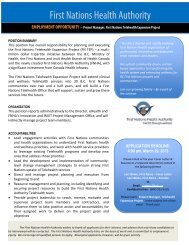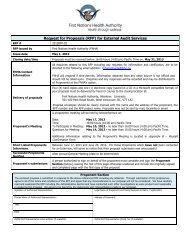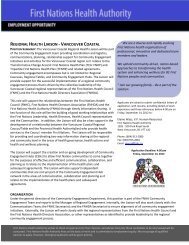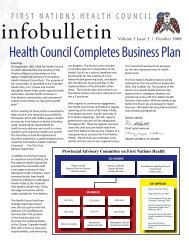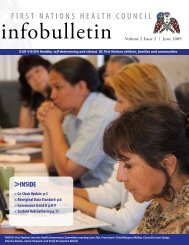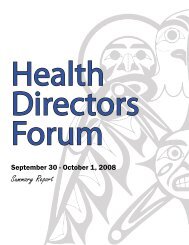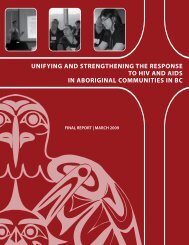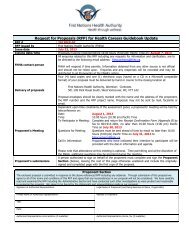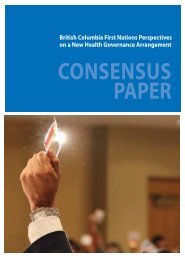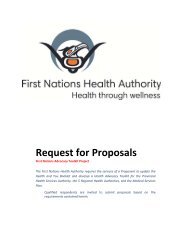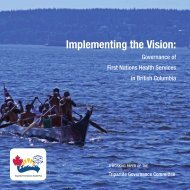BC First Nation Community Nutrition Needs & Assets Survey
BC First Nation Community Nutrition Needs & Assets Survey
BC First Nation Community Nutrition Needs & Assets Survey
You also want an ePaper? Increase the reach of your titles
YUMPU automatically turns print PDFs into web optimized ePapers that Google loves.
<strong>BC</strong> <strong>First</strong> <strong>Nation</strong><strong>Community</strong> <strong>Nutrition</strong><strong>Needs</strong> & <strong>Assets</strong> <strong>Survey</strong>
<strong>BC</strong> <strong>First</strong> <strong>Nation</strong> <strong>Community</strong> <strong>Nutrition</strong><strong>Needs</strong> and <strong>Assets</strong> <strong>Survey</strong><strong>First</strong> <strong>Nation</strong>s are disproportionately impactedby chronic disease in British Columbia. If wethink back to a time when chronic disease didnot exist for our people, we will note that we livedin a way that was very physically active, and that ourfood was acquired close to home. These healthyliving patterns are a big part of what keeps us well.<strong>Survey</strong>s in our communities indicate that notenough children are eating the daily recommendednumber of fruit and vegetable servings, and thatmany of us have work to do towards achieving ahealthier weight.The <strong>First</strong> <strong>Nation</strong>s Health Council believes thatpromoting healthy eating involves changing thecommunity nutrition environment. This includeschanges that we can make individually, in ourfamily, in preschool, at school, and throughout thecommunity. Many of these changes involve taking astep back.To guide nutrition programming for <strong>First</strong> <strong>Nation</strong>sin <strong>BC</strong>, the <strong>First</strong> <strong>Nation</strong>s Health Council nutritionistdeveloped a needs/asset questionnaire to learnfrom community health workers about the currentnutrition environment, including what is currently inplace to promote healthy eating, and what they feltwould support the promotion of healthy eating.<strong>Survey</strong>s were completed by 104 health and humanservices staff representing just over 50% of <strong>BC</strong> <strong>First</strong><strong>Nation</strong>s. They were completed by hard copy at anannual Health Directors Forum as well as throughan on-line survey tool. There was a good responsefrom all provincial health authorities except VCHAand the Nisga’a Health Authority. Responsesranged from 37% - 81% of all bands in a givenhealth authority. The questions related to accessingfood, barriers to good nutrition, existing foodand nutrition programs and community nutritiontraining and resource needs.HighlightsWhere do we get our food?Many communities reported getting food locally bysome means of harvesting.Food Acquisition<strong>Community</strong> FreezerProgram<strong>Community</strong> gardens &kitchensHunting, fishing & gatheringsharing (group)Hunting, fishing & gathering(individuals)0% 10% 20% 30% 40% 50% 60%2 <strong>BC</strong> <strong>First</strong> <strong>Nation</strong> <strong>Community</strong> <strong>Nutrition</strong> <strong>Needs</strong> and <strong>Assets</strong> <strong>Survey</strong>
<strong>Community</strong>Distance from Storesgreaterthan20km31%10-20km15%5-10km11%less than5 km43%Fast food is also readily accessible as indicatedby 50% of communities. This compares withshorter distances to travel to grocery stores - with41% living less than 5km from a store, and 11%between 5-10 km away. Accessing a grocery storeis still a long journey for many <strong>BC</strong> <strong>First</strong> <strong>Nation</strong>swith 14% living 10-20km away, and 30% having todrive more than 20km.There are a variety of community based programsthat include food for community membersincluding, prenatal/postnatal programs, elderslunches, Good Food Box Programs, communitykitchens etc.Access to Dietitian ServicesAlmost a third (28%) of <strong>BC</strong> <strong>First</strong> <strong>Nation</strong>s accessdietitian services at least once a month; however,the majority indicated that there was very limitedor no access to a dietitian in their community (e.g.“plan for dietitian visits for workshops 3 - 4 timesper year.”) Health workers generally know whereto access dietitian services (hospitals, diabeteseducation centre, local health centres and publichealth, and provincial programs such as Dial ADietitian) and also identify barriers to accessincluding:• transportation and time to travel to dietitian• availability of dietitians• individuals/community are not aware of thepotential benefits or services available• individual barriers such as motivation tochange; discomfort with health professionals;sense of futility towards change with respect toenvironment and limited resources<strong>First</strong> <strong>Nation</strong>s Health Council 3
Daycare and School <strong>Nutrition</strong>ProgramsMost communities with children’s programsand schools are offering meals in the form ofbreakfast, lunch or snacks. As the majorityof respondents do not work directly in theseprograms it was difficult for them to respondto questions about how the menus are decidedor what foods are served in the meal programs.This finding also ties in with the lower ratesat which health staff reported working closelywith education staff on nutrition relatedprogramming.The majority (77.4%) supportchanging meal/snack programs tomake them more healthy ...The majority (77.4%) do support changing meal/snack programs to make them more healthy,mentioning ideas such as changes to portionsizes, providing only nutritious foods, increaseduse of traditional foods, removing pop, chips andjuice from programs, increasing vegetables andfruits, and nutrition education for the cooks.Barriers to Healthy EatingWe acknowledge the numerous barriers to healthy eating that continue to be identified and share thesupport of some potential ways to promote healthier eating in our communities. Even though many ofthese programs already exist, they need to be offered more often.Barriers to Healthy EatingWays to Promote Healthier Eating• High cost of food relative to income• Access to fast food options• Capacity constraints at the communitylevel to work toward reducing food insecurity• Lack of skills to make healthy foodchoices, cooking, gathering, harvestinggardening, storing/preserving• Access to grocery store and distance totravel• Poor quality foods in community stores• Lack of community ownership as to whatis readily available/accessible.• After school nutrition and physicalactivity program• Have cooking skills programs for families• Hold more community kitchens focusedon family nutrition.• Increase vegetable dishes on the tableat community events, meetings, andcommunity food programs such as schoollunches.• Subsidize the cost of vegetables andfruits• Increase local knowledge regardinggrowing, harvesting and using traditionalfoods.4 <strong>BC</strong> <strong>First</strong> <strong>Nation</strong> <strong>Community</strong> <strong>Nutrition</strong> <strong>Needs</strong> and <strong>Assets</strong> <strong>Survey</strong>
TrainingFuture training options that are mostsupported include:• Healthy eating and menu planning for healthworkers, teachers, parents and cooks• Traditional Foods• Developing a healthy food policy• <strong>Community</strong> Kitchens• <strong>Community</strong> Gardens• Corner Store Healthier Choice ProgramExisting FNHC Programs &Initiatives• <strong>First</strong> <strong>Nation</strong>s Healthy Foods GuidelinesResource for Planning Meals in <strong>Community</strong>• Traditional Foods <strong>Nutrition</strong> Fact SheetsEducation/Promotion Resource• Act Now <strong>Community</strong> Tool Kit Resource forPlanning a Variety of <strong>Community</strong> WellnessActivitiesHealthy Eating InitiativePartnerships• Healthy Foods and Beverages Program(<strong>BC</strong>HLA/<strong>BC</strong>RPA) – Supports work aroundcommunity food policy and access to healthyfoods.• Food Skills For Families (<strong>BC</strong>HLA/CDA) –<strong>Community</strong> facilitator training for a 6 weekhealthy cooking program.Future Directions<strong>Community</strong> Food PolicyLess than half of communities have foodpolicies/healthy eating guidelines in place,while most express interest in developingthese. Food policy development is especiallysupported for schools and is well supportedfor community events and meetings.The input from community health workershelped determine some potential futuredirections for nutrition programming for <strong>BC</strong><strong>First</strong> <strong>Nation</strong>s:• A survey for daycare and school-based mealprograms will provide focused direction toprogramming.• Training priorities include those that increasecommunity capacity to address foodsecurity, healthy meal planning for cooks,and build traditional food knowledge andskill.• Communities would like support and trainingin food policy development.• Part-time community based healthpromoters with a nutrition focus aresupported.<strong>First</strong> <strong>Nation</strong>s Health Council 5
Sharing Wisdom• If you would like more information regardingFNHC <strong>Nutrition</strong> initiatives,• or if you need answers to your questionsregarding this report,• or if you would like to provide input intofuture directions,...please contact:Suzanne Johnson, R.D. <strong>Nutrition</strong>ist778-227-4455 or sjohnson@fnhc.ca1205-100 Park Royal SouthWest Vancouver, <strong>BC</strong>V7T 1A2Phone: 604.913.2080Facsimile: 604.913.2081Toll free: 1.866. 913.0033E-mail:info@fnhc.caWebsite: www.fnhc.ca


